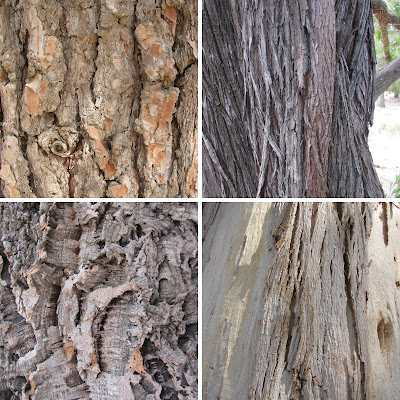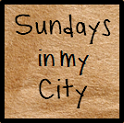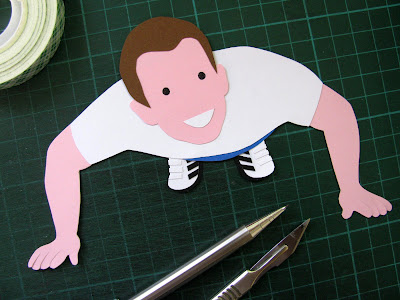I haven't written a post about my adventures in Israel for some time. My kids are getting older and don't come out with me as much as they used to, but my Dad was here recently for the holiday of
Sukkot and some time after. He was more than ready to come exploring with me, even if it meant that the explorations were at a slower pace than usual!
We made a return visit to the
Ilanot National Arboretum, which was planted in the early days of the State of Israel to test the possibility of acclimatizing different tree varieties to local conditions. As the years passed the forest was abandoned and suffered from neglect, until the
Keren Kayemeth LeIsrael-Jewish National Fund (KKL-JNF) took it in hand and revived it. My Dad is a keen gardener and also helped raise money for the JNF for many years, so this was the perfect place to start his visit, and for us to get acquainted with some foreign, strange and wondrous trees, representing a great assortment of locations all over the world.
Later that day we revisited
Gesher Hatzabim, or
Turtle Bridge, in the Nahal Alexander National Park. Turtle Bridge is one of the only places in Israel where a population of giant soft-shelled turtle can be observed. They cluster by the bridge because they can be sure of an appreciative audience of visitors, usually feeding junk food to the unfortunate beasts. Sadly the peanut butter-flavoured snack
Bamba is no better for turtles than it is for us, so really it's a terrible shame that people do it. However, the park is a great place for families to hang out, and Dad, Mister Handmade in Israel and I enjoyed a relaxing afternoon there, picnicking in the sunshine.
I had read about the Jewish Legions Museum (
Beit Hagedudim), located in
Moshav Avichail, north of
Netanya, but had not visited before and didn't know quite what to expect. As it happened, we discovered an impressive structure housing the museum on top of a hill, overlooking the wide
Hefer Valley.
The museum was established in 1961 by veterans of the Hebrew battalions (
gdudim) of the First World War. It presents the story of Jewish volunteering to the British Armed Forces during World Wars I and II. They struggled to bear a Hebrew symbol on their uniforms, yet practically designed the base on which the Israel Defence Forces were later established.
Ze'ev Jabotinsky and
Yosef Trumpeldor, early Zionist activists, led the volunteer movement and the first battalion, the
Muleteers Corps.
Jabotinsky's name showed up again when we visited the Etzel Museum in Tel Aviv, below. From 1931-1939, the
Irgun or Etzel, as it is also known (an acronym of the Hebrew initials אצ"ל, or IZL), fought against the Arabs who attacked Jewish settlements and villages throughout
Mandate Palestine. In 1939, when the British limited Jewish immigration, Etzel began to fight against the British as well. Etzel policy was based on what was then called
Revisionist Zionism founded by Ze'ev Jabotinsky.
The museum explained the context for the Etzel’s formation and about events in the country at the time. We learnt about Etzel members and the many Etzel missions, the strategy for each attack and how it played out. The museum was informative, if a little dry. Dad and I were the only ones there and we had the whole place to ourselves on the day we visited.
Another day we visited the new Israeli Police Heritage Museum, in the same complex as the National Police College, near Beit Shemesh. This wonderful museum only opened in April 2015 and I wasn't sure what to expect. It turned out to be a real treat!
The museum presents visitors with the story of the police in the Land of Israel, from the Hebrew preservation organisations in the late
Ottoman period and the British police, through to the establishment of the Israeli Police and operations over the years, up to the police as we know it today. The exhibition includes unique historical exhibits, which illustrate the development of policing in its earliest days to the present, as well as multimedia presentations that contribute to the experience of the tour.
And finally, towards the end of Dad's visit, we went off to explore beautiful
Jaffa, thought to have been the port from which
Jonah left in the story of the whale. It is also associated with the biblical stories of
Solomon and
Saint Peter, as well as the mythological story of
Andromeda and
Perseus, and of course later with
oranges.
We started the day at the port (known as Namal Yafo), which used to be a hangout for fisherman, lone artists and the homeless. After major renovation of its old warehouse buildings, the port is now teeming with life and culture, from galleries and cafés, to some of the hippest nightclubs in the Middle East. Afterwards we climbed the steps up to restored Old Jaffa. After Israel’s independence in 1948, Jaffa was twinned with Tel Aviv. For 20 years, it was home to impoverished Arabs and Jewish immigrants from Arab countries. Then, in 1968 a decision was made to rebuild Jaffa. Old buildings, structures and alleys were restored. Parks and gardens were created. The beach was beautified. Over the years it has become filled with artist quarters, studios and art galleries. Shops with Judaica and jewellery now line its narrow alleys, which are named after Zodiac signs.
Visiting Jaffa without eating something would be a mistake, as it is home to a number of unique restaurants and food stands. Dad had yet to taste a
falafel on this visit, so we stopped off at the famous Abouelafia and Sons. The legendary Abouelafia bakery, an Arab-Israeli-run establishment, has been in operation since 1879. Open 24 hours a day, it offers long bagels, many kinds of pita,
sambusak stuffed with cheese, and savoury sesame-studded
bourekas. We opted for a sit down meal in their second location opposite, and thoroughly enjoyed the freshly baked pita bread stuffed with hot falafel balls and creamy hummus.
Our final stop of the day was at the Jaffa Flea Market, or in Hebrew, Shuk Hapishpishim. This neighbourhood of alleyways, covered walkways and outdoor verandas has been operating for more than 100 years across the same sprawling streets, and is one of the highlights of Jaffa. Filled every day with tourists and locals alike, the market is a clash between the old and the new, a place where you can find Israeli antiques from the 1960s, second-hand clothes, brass, old Persian carpets and jewellery, along with some good restaurants and several boutiques selling new products that mix in flawlessly with the antiques. The market is lively and the atmosphere great! It was the perfect place to end our visit to Jaffa.



















































































